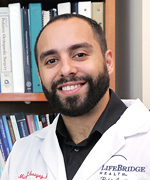Cavus Foot
What is cavus foot?
Cavus foot, also called high-arched foot, is a condition where the arch of the foot is higher than normal. It can occur at any age and can affect one or both feet. When people with this condition walk or stand, an excessive amount of weight is placed on the ball and heel on the foot, and this can cause pain, calluses and instability (“weak ankles”). Because the arch of the foot is so high, people with cavus foot also tend to have a difficult time finding shoes that fit properly. The high arch of the foot can also make the ankle roll outward, which can lead to more ankle sprains. If a person has cavus foot, they may also have foot drop, which is a weakness of the muscles in the foot and ankle that results in dragging the foot when taking a step.
What causes cavus foot?
Possible causes for cavus foot include:
- Neurological disorders;
- Medical conditions such as: cerebral palsy, Charcot-Marie-Tooth disease, spina bifida, polio, muscular dystrophy, and stroke;
- Inherited condition; and
- Some high-arched feet are a variation of normal anatomy.
Depending on the cause, cavus foot can worsen if left untreated. If the cause is related to a neurological disorder, the condition will almost always worsen if not treated.
How is cavus foot diagnosed?
Cavus foot is diagnosed by first looking at the patient’s family medical history. The physician will examine the arch of the foot. They will look to see if the patient has any calluses, hammertoes and claw toes, as these may also be signs of cavus foot. The doctor will also assess the muscle strength of the foot and the patient’s walking patterns and coordination. The physician may order X-rays to further evaluate the foot. If the suspected cause of cavus foot is neurological, the physician will also evaluate the entire limb and may refer the patient to a neurologist for a neurologic evaluation.
What is the treatment for cavus foot?
Nonsurgical treatment of cavus foot includes:
- Custom orthotic devices to fit into the shoe to provide stability and cushioning,
- Shoe modifications, and
- Braces to keep the foot and ankle stable.
Surgical treatment for cavus foot is considered if nonsurgical treatment is unable to relieve pain, restore stability and/or strengthen the foot. Surgical techniques for cavus foot can include soft-tissue surgery and tendon transfers, a deformity correction where bones are cut (osteotomy) and realigned, or fusion—where a damaged joint between two bones is removed so the two bones grow together over time. Patients with clawed toes may need toe surgery. If a neurological problem is present, additional surgery may be needed depending on the progression of the disorder. The surgeon evaluates each patient’s individual case to determine which type of surgery would be most effective.
Why choose the International Center for Limb Lengthening for treatment of cavus foot?
With a collective experience of over thirty years of helping patients with lower leg, foot and ankle problems, the Foot and Ankle Service of the Rubin Institute is one of the leading treatment centers for foot and ankle conditions in the United States. Your doctor at the International Center for Limb Lengthening will take the time to make sure you understand all your options and then will customize your treatment to meet your specific needs. Our patients benefit from our team-centered approach with world-renowned surgeons and specialized physician assistants, nurses and physical therapists. We help patients with a cavus foot achieve their best possible result.
Doctors who treat cavus foot
†Children and Adolescents/Young Adults Only





